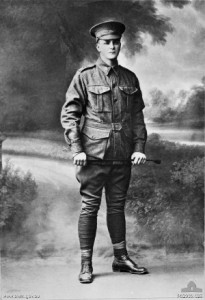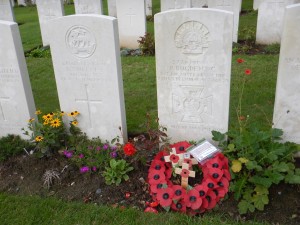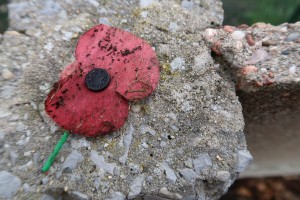
Private Patrick Joseph Bugden VC
31st Battalion Australian Imperial Force
(Wiki Image)
Polygon Wood, Zonnebeke, Belgium: Action of 28 September 1917
THY WILL BE DONE NOT MINE
For most conspicuous bravery and devotion to duty when on two occasions our advance was temporarily held up by strongly defended “pill-boxes”. Pte. Bugden, in the face of devastating fire from machine guns, gallantly led small parties to attack these strong points and, successfully silencing the machine guns with bombs, captured the garrison at the point of the bayonet. On another occasion, when a Corporal, who had become detached from his company, had been captured and was being taken to the rear by the enemy, Pte. Bugden, single-handed, rushed to the rescue of his comrade, shot one enemy and bayoneted the remaining two, thus releasing the Corporal. On five occasions he rescued wounded men under intense shell and machine gun fire, showing an utter contempt and disregard for danger. Always foremost in volunteering for any dangerous mission, it was during the execution of one of these missions that this gallant soldier was killed [28 September 1917].
On this day the journey took us around Vijver van Zillebeke [Zillebeke Lake] towards Zillebeke Churchyard, and the 15th Canadian Infantry Battalion (48th Highlanders) 2-3 June 1916 commemoration at Observatory Ridge. Here the plaque’s inscription describes the battalion’s experience in simple few words…The mad crescendo runs. On the Woeful Waiting Ones. The huddled World in Waiting. ‘Neath the Guns.
The words provide more to think upon as I pedal, winding our way to Maple Copse Cemetery and Larchwood (Railway Cutting) Cemetery very near to Hill 60. It is at Larchwood where one bicycle tire succumbs to the pressures of the road inadvertently providing more ponder time at Larchwood as we await repairs from our Ariane hosts. I take time, missing one fleeting train, but in good time for another taking shots in series as it passes. The train’s pace stark contrast to those who remain here at Larchwood. Once we return to the road Chris and I make a study on Hill 60 and the surrounding area. There is boardwalk here now, much finer than the duckboards of the Great War. Tour buses deliver persons with similar interests or with family closeness to this era. We head to Hooge Crater Cemetery to end our touring day where I find Patrick Joseph Bugden VC. It is a walk. of pauses..with time to find, before refreshments and food at the Hooge Crater Museum and Restaurant, the places where visitors have left their own remembrances to the fallen.

Bugden marker (on right) at Hooge Crater Cemetery, Belgium. Age 20.
(P. Ferguson image, September 2017)
Helpful Link
Australian War Memorial

Remembrance at Hooge Crater Cemetery.
(P. Ferguson image, September 2017)
Tags: 15th Canadian Infantry Battalion (48th Highlanders), 28 September 1917, 31st Battalion Australian Imperial Force, Hill 60, Hooge Crater Cemetery, Larchwood (Railway Cutting) Cemetery (Belgium), Maple Copse Cemetery, Observatory Ridge, Patrick Joseph Bugden VC, Polygon Wood, Poppy, Posthumous Victoria Cross
This entry was posted by pferguson
on Monday, November 7th, 2022 at 6:43 am and is filed under November Series, Remember Them Well.
You can follow any responses to this entry through the RSS 2.0 feed.
You can leave a response, or trackback from your own site.
About The Author

Paul has worked with the Paradigm Motion Picture Company since 2009 as producer, historian and research specialist. Paul first met Casey and Ian WIlliams of Paradigm in April 2007 at Ieper (Ypres), Belgium when ceremonies were being held for the re-dedication of the Vimy Memorial, France.
Paul's sensitivity to film was developed at an early age seeing his first films at RCAF Zweibrucken, Germany and Sardinia. Paul returned to Canada in 1967 and was captivated by David Lean's "Lawrence of Arabia" and "Bridge on the River Kwai". Over time Paul became increasingly interested in storytelling, content development, character, direction, cinematography, narration and soundtracks.
At the University of Victoria, Paul studied and compared Japanese and Australian film and became interested in Australian film maker Peter Weir and his film "Gallipoli" (1981). Paul was inspired when he learned Weir visited the beaches, ridges and ravines of the peninsula. "Gallipoli", the film, led Paul on many journeys to sites of conflict in England, France, Belgium, Holland, Germany, Malta, Hawaii, Gallipoli, North Macedonia and Salonika.
When Paul first watched documentary filmmaker Ken Burns, "The Civil War", Paul understood how his own experience and insight could be effective and perhaps influential in film-making. Combining his knowledge of Museums and Archives, exhibitions and idea strategies with his film interests was a natural progression.
Paul thinks like a film-maker. His passion for history and storytelling brings to Paradigm an eye (and ear) to the keen and sensitive interests of; content development, the understanding of successful and relational use of collections, imagery and voice. Like Paul's favorite actor, Peter O'Toole, Paul believes in the adage “To deepen not broaden.”
While on this path Paul always remembers his grandmother whose father did not return from the Great War and how his loss shaped her life and how her experience continues to guide him.




Comments